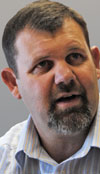

SA Instrumentation & Control interviewed a number of Honeywell Automation & Control Solutions (ACS) senior executives during the recent Honeywell Users’ Group (HUG), which took place in Barcelona. The interviews covered numerous topics, including technology trends and expectations of future business performance.
A virtual update
In the March 2010 issue of SAI&C we looked at some of the potential benefits that computer virtualisation can offer industrial control. In the article, Honeywell’s director of sales and support in the EMEA region, Jean-Marie Alliet stressed that Honeywell was not going to jump in at the deep end of this relatively new technology. At that time the company was not using virtualisation technology in mission-critical applications ie, only in monitoring applications.
Now, 12 months later, we again asked Alliet for an update on the status of virtualisation.
“Honeywell has taken an approach that starts from the top level ie, business control/IT (level 4) moving downwards to the lower levels,” says Alliet. “At this stage we have progressed down to level 2. Level 2 in turn has four sub-levels:
4. Small scada systems.
3. Hybrid systems.
2. Large scada systems.
1. Distributed control systems (DCS).
“Large scada is scheduled for the beginning of 2011 and we expect to have reached the bottom level (level 1 ie, DCS) in the latter half of 2011.”
Virtual driving forces
Honeywell’s technology vice president, Jason Urso, suggests that there are still three major drivers for virtualisation:
1. A reduction of the number of physical PCs in a plant.
2. Reducing the impact of operating system and hardware changes- ‘hardware/OS churn’.
3. Simplified and unified system management.
“We see North America as being the most progressive region in adopting virtualisation, followed by the Pacific Rim, and then Europe, Middle East and Africa (EMEA region) and Asia. That said, there is so much diversity. Some countries like Singapore are very progressive. For India and China their countries’ cost structures differ significantly from those in Western Europe or North America. Indian and Chinese labour costs tend to be significantly lower than those in the latter, so the manpower costs related to complex system maintenance are less of a driver for them.
Virtual hiccups
But, as can be expected with any new technology, the introduction of virtualisation has not always been easy. Urso described a few of the common hurdles that end-users have faced in virtualisation.
“The most common issue is that of ‘estimation’ ie, estimating what type/level of hardware is required to when replacing legacy equipment. In the old environment estimation was relatively easy... one PC replaced one PC. Now we need to estimate how many PCs can we fit into a new virtual environment. By nature, engineers tend to be more conservative and would rather over-spec a project, than under-spec it. As a result, we find that clients more often than not grossly over-estimate the hardware requirements of a virtual system.
“The result of this sort of over-spec miscalculation is that a very expensive virtual server may sit virtually idle, when a significantly cheaper configuration could have done the task that was required.” Urso suggests that as exposure to virtualisation increases, right-sizing will become easier and easier.
“Another issue is that of ‘system robustness versus price’,” continues Urso. “The more PCs one puts into a virtual environment, the more one puts more eggs in one basket. One then has to increasingly protect this basket by introducing more redundancy.
“Of course, any level of redundancy is possible... but at a price. Our industry tends to be incredibly cost conscious. That said there is a continuum. For some clients, cost is everything. Other clients will demand the very best and are prepared to spend. So for Honeywell it is about designing a system that is capable of spanning this entire range of customer requirements.”
Virtual design issues and skill sets
“Designing a system for a virtual environment has very different requirements to designing for a traditional environment. For an initial deployment one can get away with a fairly basic skill set. But as the deployment increases in size and complexity and moves into more advanced but absolutely required technologies, such as central storage, then the skill set required takes a significant jump.
“We believe that this is where Honeywell adds value. We have considerable expertise in many areas that clients may have a shortage of skills.”
African outlook for Honeywell
Next under the spotlight was KwaZulu-Natal born Sean Smith, the regional general manager of sub-Saharan Africa for Honeywell Process Solutions. Considering that this geographical region includes the Republic of South Africa and the Oil and Exporting Countries (OPEC) of Nigeria and Angola, this is not a region to be sneezed at. We asked Smith what forces he believes are driving advances in automation technology.

“Firstly, I believe that most people do not realise that the control system in a plant houses the most complete representation of any company’s intellectual property,” said Smith. “One can have standard operating procedures, design documents, and training manuals... these are all very important. But the only thing that really knows how to control the plant (and therefore knows how to produce the end product) is the control system.
“A term that I believe sums up the force is that driving technology is ‘smarter’. By this I include not only operator decision support systems, but also ‘putting things closer to the source’. In the past it was not uncommon for an operator to have four or five different platforms that he had to interact with. We increasingly see customer capability declining, as is supplier capability. Skilled persons are difficult to get hold of... training is just not occurring at the level that it was in the past (we see this in South Africa in particular). So I think that what we are seeing is that instead of the operator closing the figurative and literal loop, we see the need for more smarts being put closer to the control room and the operator having to only interact with very simple interfaces. Of course, this does put more pressure on us, ie, the plant engineers and the engineering suppliers.”
Growth opportunities for sub-Saharan Africa
Just over a year ago Smith’s predecessor, Elgonda le Grange, was re-assigned to manage the northern European region of HPS. During le Grange’s tenure as the manager for sub-Saharan Africa, she put very aggressive growth targets in place for HPS. We asked Smith if these were still achievable, especially considering the recent slow-down/collapse of many economies.
“It is critical to differentiate between the potential growth of the Republic of South Africa market versus other countries in the region (ie, other sub-Saharan African countries). As far as the world is concerned, southern Africa is considered an emerging market for growth rates. Emerging markets have growth rates of 10-20%. The Republic of South Africa is not an emerging market for growth rates when we consider the level of investment that is going into manufacturing, petro-chemicals, energy etc.
“If we look at the very significant investments that are taking place in the Republic of South Africa, these are typically infrastructural investments to ‘catch-up’, eg, housing, roads, power. We do not anticipate any major investments in manufacturing or processing in the near future. For example, in September 2010 the Sasol Mafutha (aka Sasol IV) project was ‘decelerated’ pending various studies and tests. For the other existing refineries, investment has not also been great, and that which there has been, has being driven only by the new fuel specifications ie, the ‘growth’ is not new refining capability.”
Smith continues, “Looking at the Republic of South Africa market, Honeywell’s growth will be in modernising and optimisation of our existing customers’ businesses. Take for example, Sasol... a very, smart customer of ours. Sasol will continue to drive ‘more, with less’... that is what Sasol does well.
“It is my opinion,” says Smith, “that growth is still possible in the Republic of South Africa, but not at the figures we envisaged before the economic collapse. However, sub-Saharan Africa (excluding the Republic of South Africa) is a different kettle of fish.
Africa excluding Republic of South Africa
Smith justifies his reasoning, “Honeywell recently established an office in Nigeria through a joint venture partner and has opened a principal office in Angola. In countries such as these we are seeing a different growth mix eg, there are a number of refineries being built. I believe that a significant part of our potential success in these countries is a programme that we have called One Honeywell.
“By way of example, Honeywell owns a company called OPC that offers process licences ie, we are offering design solutions at a process level, not just an engineering level. Customers increasingly look to us to optimise their business from the design phase. Customers would prefer to not let some third-party contractor come up with a design, get it going, hand it over to the customer (at a minimum running speed) and then just walk away... leaving the customer up to itself to go forward. I believe that our strategy allows us to offer the customer help with a significant part of:
* The process design.
* The licensing.
* The technology design, carrying that through into:
- The operator training.
- The simulation.
- The implementation.
- The optimisation.”
Smith concludes, “In sub-Saharan Africa where these new builds are taking place, our growth plans are still entirely achievable.”
For more information contact Debbie Rae, Honeywell Southern Africa, +27 (0)11 695 8000, [email protected], www.honeywell.co.za

© Technews Publishing (Pty) Ltd | All Rights Reserved